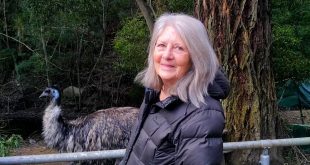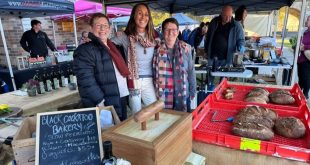
A section of Mary’s Garden after the Autumn 2023 Working Bee (Tracie McMahon)
By Tracie McMahon
With an upcoming Intergenerational Gardening Day at Eskbank House on April 13 (read more below), garden volunteer and writer for the Lithgow Sprint, Tracie McMahon, provides a background to the establishment of the thriving heritage garden at Eskbank House Museum. Mary’s Garden is a catalyst for growing community, connection to nature, an understanding of history and food security.
For years the volunteers of Eskbank House Museum, would gaze out from Mary Brown’s restored sandstone home onto a patch of dried grass, replete with faded garden gnome. Over countless cups of tea, they imagined what the yard looked like for the original inhabitants of the 1850’s and dreamt of a garden befitting its surroundings.
In 2020 those dreams became reality.
The history of the Browns and Eskbank House
Thomas and Mary Brown were Scottish immigrants and among the first landowners in the Lithgow valley. During the 1840’s and 1850’s, Thomas Brown was Commissioner of Crown Lands, Police Magistrate, and also a Member of the NSW Parliament. The Eskbank Estate, which included the Steelworks site, is however considered his greatest legacy. Its coal fired smelters for iron, steel and copper powered the Great Western Railway and changed Lithgow into an industrial centre. In 1841, Alexander Binning, a Scottish stone carver, built Eskbank House for the Browns from sandstone quarried locally. Little is known of Mary Brown, or day-to-day life at Eskbank House, as Thomas ordered that all his papers be destroyed on his death in 1881. Mary’s Garden acknowledges her life, not in words but in perennials, vegetables and herbs.

Eskbank House circa 1850 (courtesy Eskbank House Museum)
Information on the Browns and their tenure at Eskbank House has been derived from historic photographs, records and oral histories of subsequent residents. Mavis Britten and Betty Mackenzie, who spent part of their childhoods in the house in the 1920’s, recall the gardens included a working garden, with a vegetable patch, orchard and livestock.
Funding to create Mary’s Garden
Eskbank House Museum, operated by Lithgow City Council and a dedicated volunteer team, is one of the earliest house museums in Australia. In 2017 it received heritage funding to deliver an archeological study and establish heritage fencing and paths. In 2020, funding under the Bushfire Community Resilience and Recovery Fund made it possible to construct Mary’s Garden.
A horticulturalist with heritage expertise constructed the garden using principles of nineteenth century English and Scottish garden design, including squared central paths and rectangular garden beds. The garden is maintained by a small group of volunteers, with seasonal attendance by the horticulturalist. The geometric layout of the kitchen garden incorporated purposeful and functional plant selection including medicinal and edible herbs, flowering perennials and vegetables. Planting includes only those varieties available in an 1850’s Australian garden.

Young people in a permaculture course held at the Lithgow Transformation Hub, learning about plants and seed saving in Mary’s Garden, September 2022 (Lis Bastian)
The vision was for “the garden (to) become a space that the project participants continue to engage with, developing skills and knowledge, building friendships, or just finding a space to relax and reconnect with nature and local history.”
This vision inspired me to join the volunteer team in 2021. It is being realised with the garden hosting nature journaling, bee ecology, garden clubs and many appreciative visitors.

The perfect ‘outdoor classroom’, September 2022 (Lis Bastian)
Saving locally acclimatised seeds for the garden
Just as a garden grows and adapts to the climate, so too have the volunteer’s ideas as we harvest and divide the garden yield, and chat over a cuppa.
In late 2022, we considered how seeds could be “saved” and plants could be divided and replanted. This would ensure that subsequent crops were adapted to local conditions, as would have occurred in the 1850’s.

Volunteer Jenny Fuller planting out donated seeds in the Vegepod, with other volunteers Vida Hung, Tracie McMahon and Kathryn Newton (L-R) (Eskbank House Museum)
With the last of the grant funds we furnished the garden with seating, and purchased a raised Vegepod to allow those unable to bend quite so far, to get their hands ‘dirty’ and to assist with seed raising. We then put the call out for locally saved seed.

Vida Hung planting her saved seeds in the Vegepod (Eskbank House Museum)
As the saying goes: ask and you shall receive! Vida Hung had been saving snow pea seed for the last two seasons. Originally grown in her garden in the city, Vida brought seed with her to Lithgow and then kept seeds that produced well in her new environment. She generously offered to plant these seeds as the first locally sourced seeds in Mary’s Garden.
This seed was planted in both the main garden and the Vegepod, with other donated commercial seed, at the Autumn working bee day. With an amazing flush of hot weather and a good talking-to by the garden team, the cotyledons (first leaves) emerged in under five days.
An Intergenerational Gardening Day
We are now planning an Intergenerational Gardening Day on April 13 to plant out our seedlings, and harvest and divide other crops such as rhubarb, chicory, artichoke and sorrel. Bookings can be made at School Holidays at Eskbank – Intergenerational Gardening Day! | Eskbank House Museum (lithgow.com). While this day is aimed at children and their carers, the garden is open for everyone to enjoy Wednesday to Sunday 10 am to 4 pm. Members of the garden volunteer team are usually on hand on Wednesday and Thursday and are always up for a cuppa and a chat.
The garden is only a small part of the Museum’s activities. It has an extensive collection of local objects, which are rotated on a regular basis. At the moment, the team are unearthing treasures for an upcoming exhibition of local textiles in conjunction with the National Heritage Festival and annual Simsmetal Waste to Art Competition. The ‘reveal’ of the first of these treasures, the Nationally Significant 1893 Sutton-Leake Crazy Patchwork Quilt was posted on Eskbank House Museum’s Facebook page.
If you would like to join in on a regular basis, new volunteers are always welcome. Eskbank House Museum is wholly operated by volunteers and managed by the Museum Development Officer: Kay Shirt who can be contacted on eskbank@lithgow.nsw.gov.au.

Another permaculture class learning about plants and seed saving at Mary’s Garden, April 2021
(Lis Bastian)
This story has been produced as part of a Bioregional Collaboration for Planetary Health and is supported by the Disaster Risk Reduction Fund (DRRF). The DRRF is jointly funded by the Australian and New South Wales governments.




